The Illawarra flame tree (Brachychiton acerifolius) is an iconic tree due to its bloom of red flowers that occur during late spring. These trees are native to the east coast of Australia and can be found all over New South Wales and up the east coast of Queensland.
Illawarra Flame Tree Quick Facts Table
| Common Names | Illawarra flame tree, flame tree, lacebark tree, kurrajong, Australian flame tree |
| Scientific Names | Brachychiton acerifolius |
| Plant Type | Small to large deciduous tree. |
| Flowering time | Flowering in spring/summer. |
| Flower colour | Red |
| Climate zone | Tropical and subtropical, warm and cool temperate zones. |
| Sun/Light | Full sun, but tolerates light shade. |
| Frost/Snow | Tolerates light frost. |
| Size (height & width) | 10 to 35 metres tall, 5 to 15 metres wide. |
| Water | Water well until established. |
| Soil | Prefers well-draining loamy or clayey soil. |
| Fertiliser | Regular soil improver and plant fertiliser in autumn and spring. |
| Pests & Diseases | Possums and caterpillars (Kurrajong leaf-tier or leaf-rolling caterpillars). |
| Toxicity | The seeds are surrounded by hairs that will irritate the skin and nose and throat, they are also toxic to native birds and wildlife. |
| Propagation | Seeds |
| Plant usage | Street trees or feature trees for decoration, edible seeds when cooked. |
| Attracts wildlife | Bees and other nectar gathering insects and birds. |
History
Native to Australia, the Illawarra flame tree has a long history with the land and the Australian aboriginals.
Aboriginal people used the tree to help support themselves. The inner bark of the tree was used for making string, fishing nets and traps, as well as being a food source [source].
The Illawarra flame trees grow in the wild on the east coast of Australia. Starting from the south of Illawarra, they are found in the wild all the way up into north Queensland. They are happy to grow anywhere in Australia where the conditions are ideal though and can be brought from a range of nurseries across Australia and internationally [source].
Size
The size that an Illawarra flame tree will grow does depend on the amount of space it has. The less space available to it the smaller it will be.
Height
Height can range from 10 metres (33 feet) to 35 metres (115 feet) tall.
Width
The spread of the tree branches can be from 5 metres (16 feet) to 15 metres (49 feet).
Is There a Dwarf Illawarra Flame Tree?
There isn’t a dwarf Illawarra flame tree, some people do try and turn them into bonsai trees though. They are definitely more suited to growing in large spaces and not being restricted to a small pot being pruned back.
According to this forum, the person who was trying to coach the flame tree to be a bonsai was having trouble with it wanting to keep growing large.
Growing Conditions
The ideal growing conditions for an Illawarra flame tree are:
- Full sun (can handle partial shade)
- Only light frost conditions (ideally no snow)
- Will adapt to almost any soil type provided it has good drainage
- Temperate and tropical climates
If your location can satisfy all the above conditions then you will be able to grow your very own flame tree in your backyard.
You can view our step-by-step guide here on How to Grow an Illawarra Flame Tree.
Flowering
The Illawarra flame tree is an iconic tree due to its flowering. It even got mentioned in a Cold Chisel song how the bright red flowering “blinds the weary driver”. The flowers are a bright red colour, measure 1 to 2 centimetres long and have a waxy surface.
Flowering will usually happen in late spring to early summer after the tree has lost some to all of its leaves, and it usually occurs annually. For new Illawarra flame trees, it can be anywhere between 5 to 8 years before their first flowering.
The flowers are a food source for nectar gathering animals such as bees and native birds.
If your Illawarra flame tree doesn’t flower one year there is a chance that you are treating it too kindly. Most native plants need some stress or adverse conditions to encourage them to flower.
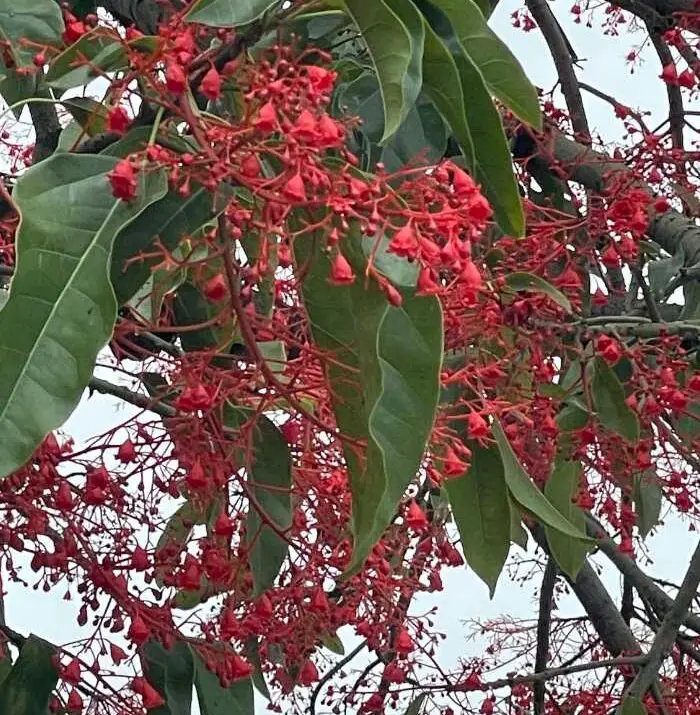
Leaves
The Illawarra flame tree leaves can be 10 – 30 centimetres long. They are dark green and oval-shaped and can have 3 – 5 or even more lobes.
Usually, a mature tree will lose all of its leaves at the end of winter before flowering. If it doesn’t lose all of its leaves at this time, there is a chance that the conditions for the tree are too good, and it is happy to keep growing.
When they drop all of their leaves it can be messy, but the leaves can be easily mowed or raked up.
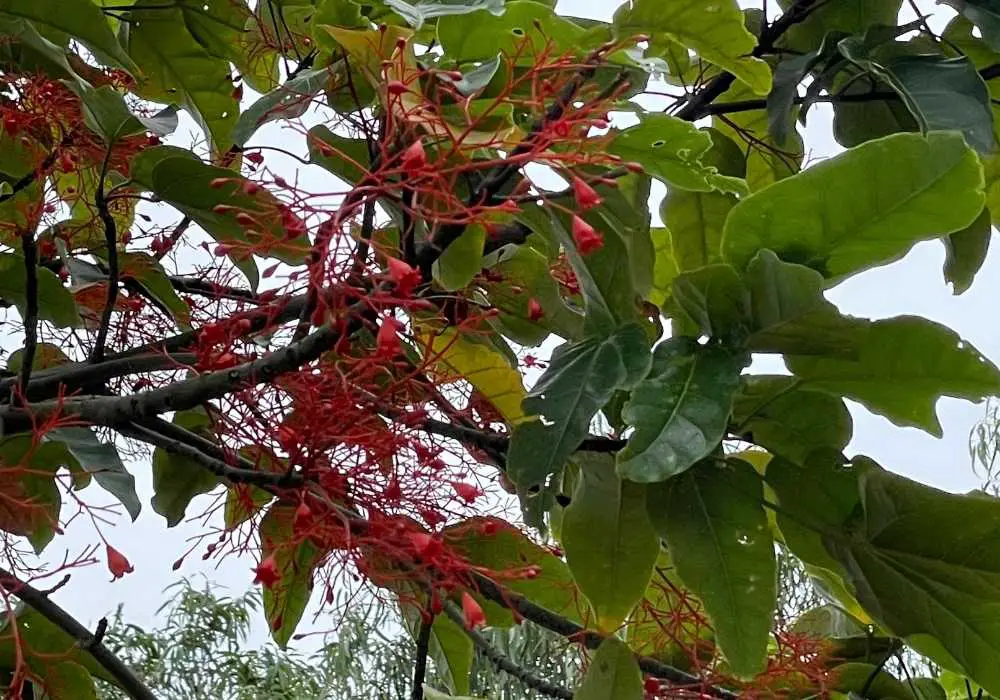
Seeds
Seed pods and seeds are produced after the tree finishes flowering. The seed pod is large, black and “boat-shaped”, and houses rows of hairy yellow seeds that look like corn.
The seeds are surrounded by hairs that are toxic to humans and animals. If you are planning on handling the seeds make sure you wear gloves.
The aboriginals used to eat the Illawarra flame tree seeds. To prepare them to be eaten they would roast them in a fire, which would remove the toxic hairs. The seeds are nutritious and a good source of protein and taste somewhat like a raw peanut.
Care
Once these trees are established there isn’t a great deal of care that is required. Other than the occasional fertiliser if required, and if there is a long drought period they will like to be watered until the rain returns.
When growing an Illawarra flame tree from seed or sapling you will need to keep up with regular watering and fertilising (use a native fertiliser and follow instructions on the packet). Placing mulch around the tree will also help the soil retain moisture and protect the young tree from any long periods of time between watering.
Pruning
If your Illawarra flame tree is becoming overgrown and it needs to be pruned back, yes it can handle heavy pruning. It’s best to leave it until after it has finished flowering in late summer if you can. Cutting off any dead or damaged branches will help the tree focus its growth on its healthy branches.
Frost/Snow
The Illawarra flame tree can tolerate light frost, but if during winter they are getting more frost than usual, make sure you keep an eye on the condition of the tree.
Relocating/Transplanting
If you need to relocate or transplant your Illawarra flame tree, follow these steps to try and ensure success [source]:
- Dig two slim trenches either side of the tree a few months before you plant to move the tree. This will encourage root growth in the trenches.
- When you are ready to move the tree, dig another two trenchs on the opposite side of the tree. Roots should have started to form where the existing two trenches were dug, which will help reduce the stress on the tree during its move.
- Dig the new hole a bit deeper than needed, so part of the previously exposed above ground level trunck will now be burried.
- Place the tree in the hole, put in some fresh soil and fertiliser. If needed place a stake or star iron picket in to help support the tree.
- Water heavily for the first few weeks (every couple of days) while it is establishing itself. Once you see sign of new growth you will be able to back off with the watering and leave it support itself.
Illawarra flame trees do have deep taproots, breaking this doesn’t mean the end of the tree. Try preserving as much of the taproot as you can though as most of the feeding happens towards the top of the taproot.
Root System
The root system of an Illawarra flame tree is considered to be invasive [source]. If planted near a structure, their roots could damage the foundational structure of buildings, roads, footpaths and anything else similar.
Ideally, you will plant these trees at least 10 metres (33 feet) away from any structure, especially your house.
If you can’t plant it at least 10 metres away from any structure, consider growing one in a pot. It won’t grow as big but at least it will save you a huge headache and cost.
Growth Rate
Illawarra flame trees have a fast growth rate. They can grow between 60 centimetres (24 inches) to 90 centimetres (36 inches) each year.
Pests & Diseases
Diseases
The only significant disease known to affect these trees is the Crown gall, which is a bacteria that is found in the ground. This bacteria can cause unusual growth on the truck of trees which can affect its growth but does not necessarily mean certain plant death [source].
Pests
It can attract many different kinds of pests including:
- Possums
- Caterpillars (Kurrajong leaf-tier, tailed emperor or leaf-rolling caterpillars)
- Kurrajong weevil ,
- Crown gall
The most damage these pests can do is eat the leaves on the plant and provided it is well established it should always be able to outgrow and recover from any such damage.
Toxicity
The seeds produced (after flowering) are surrounded by hairs that will irritate the skin and nose and throat. These seeds are held in a dark brown, and very tough seed pod, while containing rows of seeds inside all lined up like corn on a cob.
The aboriginals of Australia used to cook these seeds in the fire. This removed the toxic hairs on the seeds before eating.
These seeds are toxic to native and domestic birds and animals.
[source]
Propagation
Illawarra flame trees can be propagated by either growing from seed or by a cutting. You can view our step-by-step guide on growing these trees using a variety of different methods in our post How to Grow an Illawarra Flame Tree.
Similar Trees
The Illawarra flame tree is part of the Brachychiton genus. There are 31 species of trees and large shrubs that are part of this genus. One of the most known trees that is in this genus is the Queensland Bottle Tree (Brachychiton rupestris).
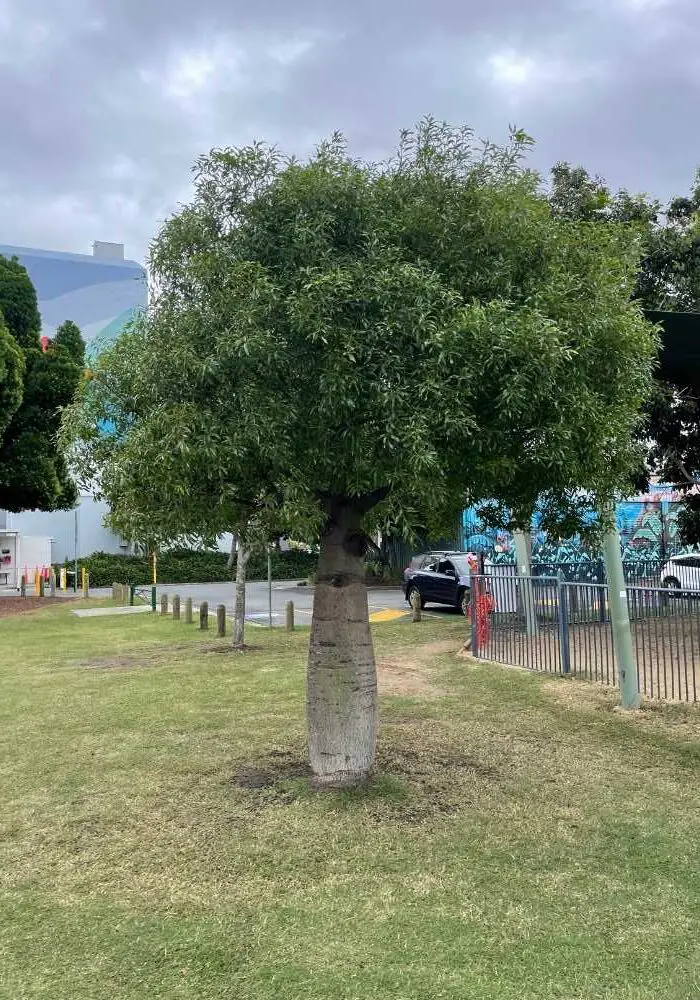
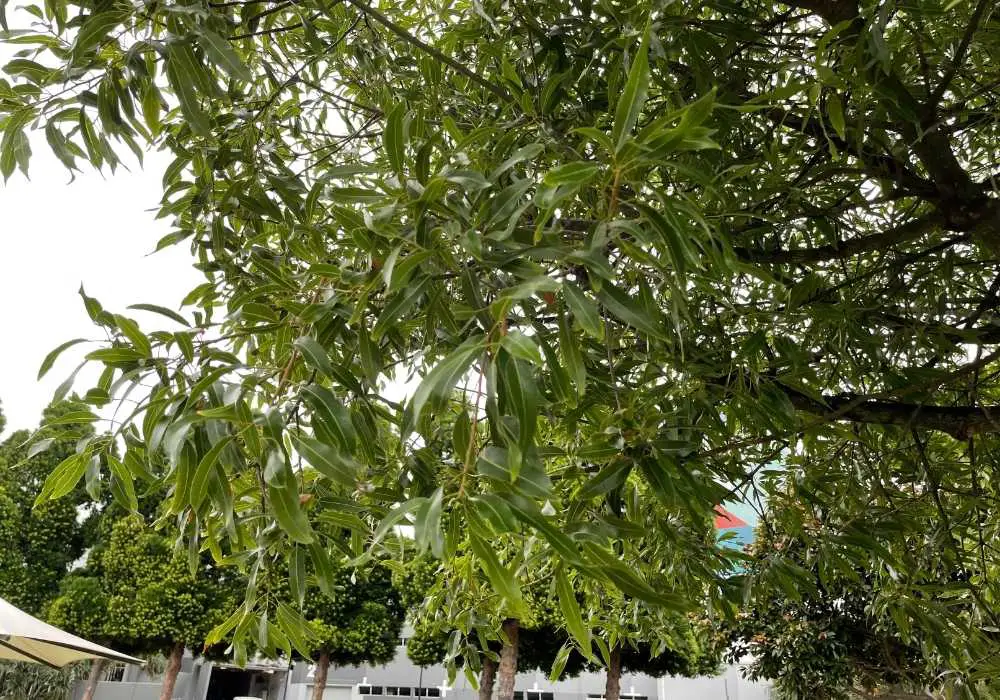
Pictures of An Illawarra Flame Tree
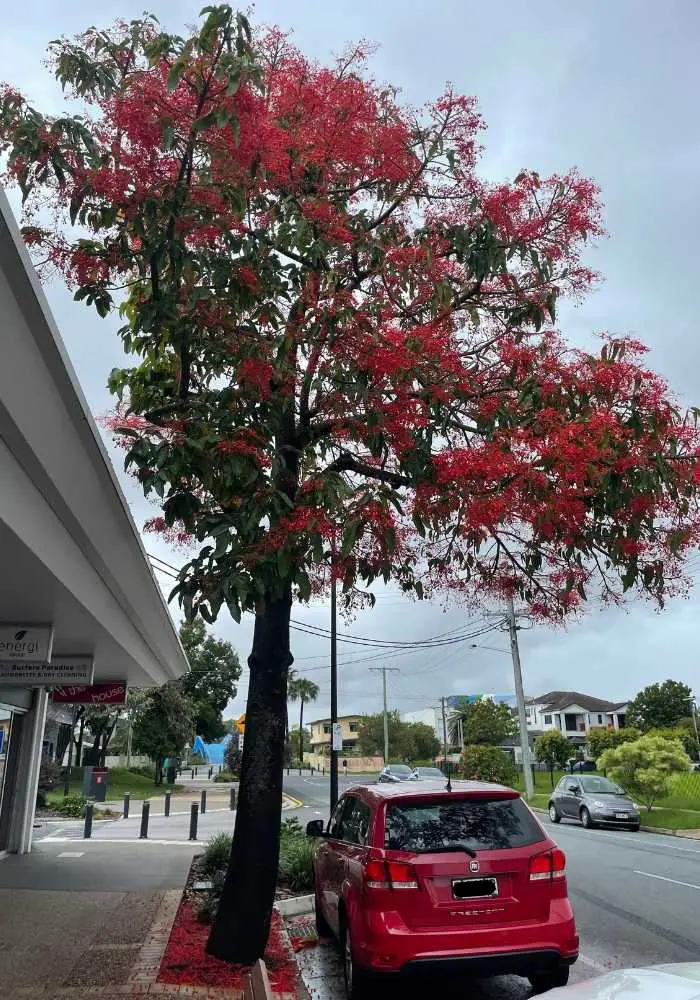
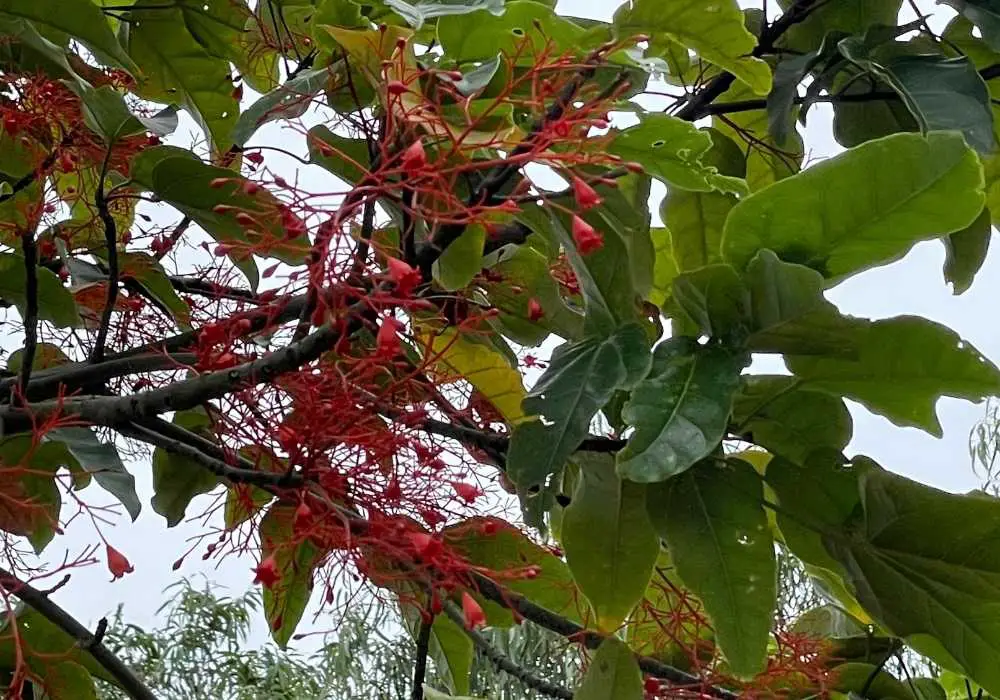
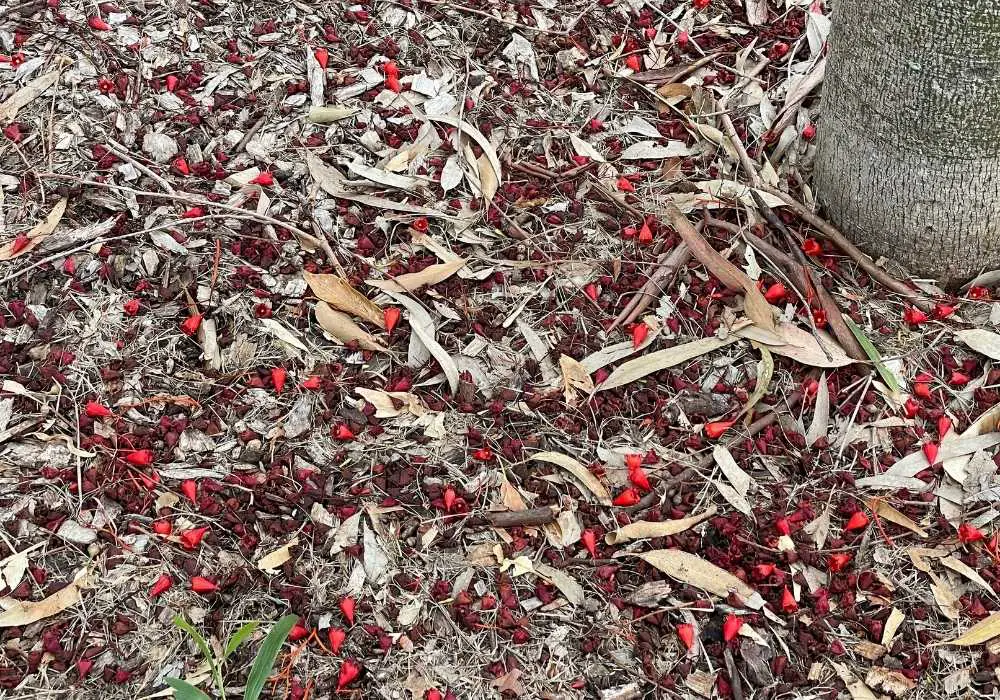

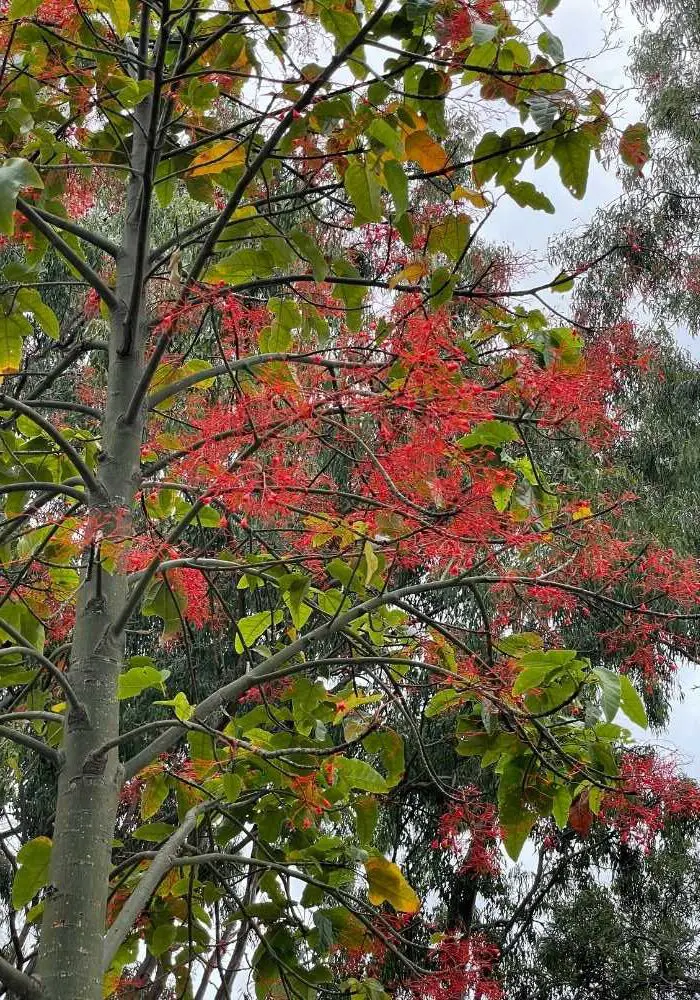
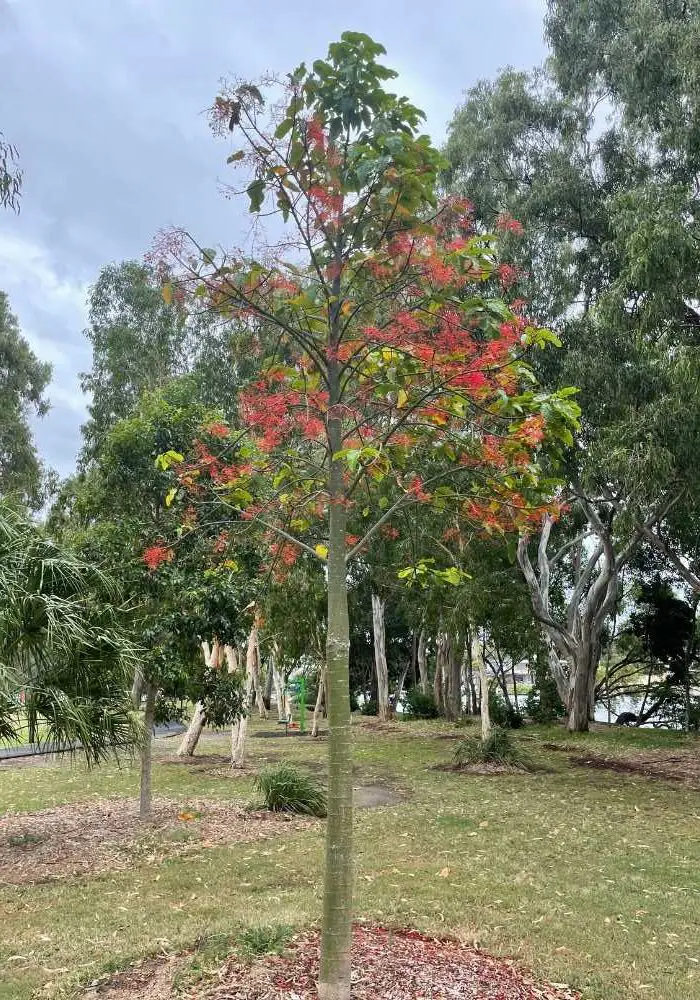
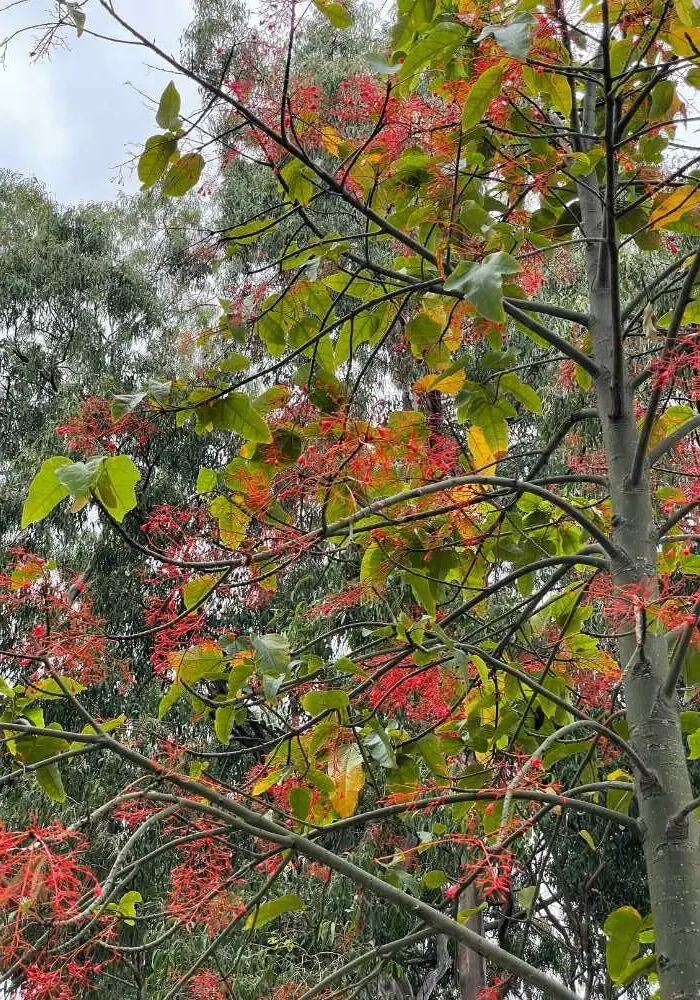
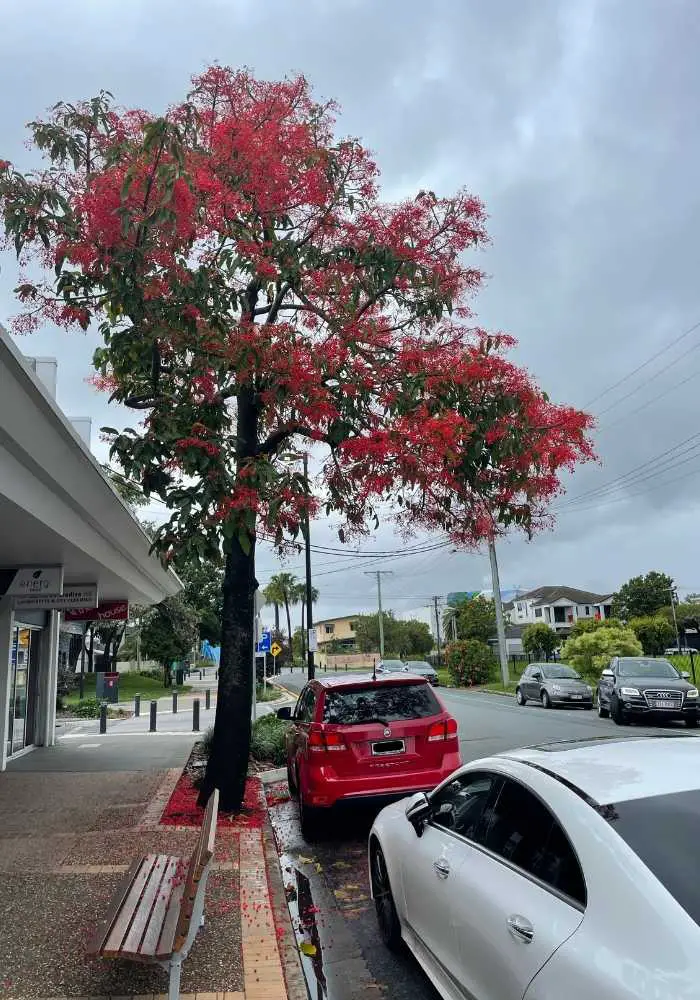
FAQs
How long do Illawarra flame trees live for?
Their life span can be anything from 50 to 150 years.
Where else can an Illawarra flame tree grow?
They can grow anywhere they satisfy the growing conditions listed here. While native to the east coast of Australia, they are found all over Australia. The have also been planted overseas in New Zealand, United States of America and other places with suitable climates.
How long does it take for an Illawarra flame tree to flower?
The Illawarra flame tree can take anywhere from 5 to 8 years for their first flowering.
Can you grow an Illawarra flame tree in a pot?
You can grow an Illawarra flame tree in a pot. However, you will need to keep on top of the plant’s growth with some aggressive pruning to prevent it from outgrowing your space or pot. They can grow almost 1 metre per growing season when planted outside in the ground.
Can I prune the Illawarra flame tree?
Yes, you can prune this tree. If you need to prune it the best time to do it would be just after flowering in late summer. This is when it is less active and won’t get stressed out with any pruning.
What does an Illawarra flame tree look like?
The Illawarra flame tree can grow up to 35 metres tall when planted with lots of space and spread out up to 15 metres wide. During spring and summer, they can drop all of their leaves and put out a display of bright red flowers (which are a bud shaped flower, 1-2 centimetres long). Their leaves can grow from 10-30 centimetres long and are a dark green colour and oval shape.
Are Illawarra flame trees messy?
They do drop their leaves just before flowing in spring, then they drop they flowers once their flowering season is over in late summer.


